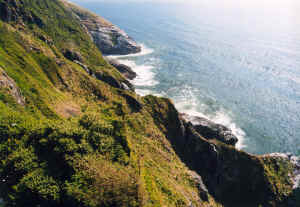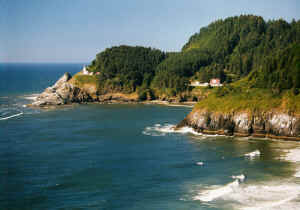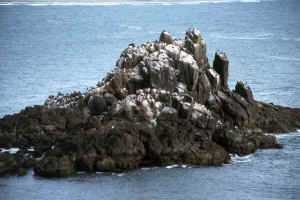No. 27. Coastal Headlands and Islets
Christopher B. Chappell and David H. Johnson
 Geographic Distribution. This shrubland, grassland, and nearshore rocky
island habitat occurs along slopes and exposed headlands along the outer coast,
from Cape Flattery, Clallam County, Washington, southward to (and beyond)
California. On small islands it also extends into the Strait of Juan de Fuca and
the inland marine waters of Puget Sound and Hood Canal, Washington. Sporadic
along the Washington coast (absent between Point Grenville and Cape
Disappointment), this habitat becomes most extensive on the southern Oregon
coast. Geographic Distribution. This shrubland, grassland, and nearshore rocky
island habitat occurs along slopes and exposed headlands along the outer coast,
from Cape Flattery, Clallam County, Washington, southward to (and beyond)
California. On small islands it also extends into the Strait of Juan de Fuca and
the inland marine waters of Puget Sound and Hood Canal, Washington. Sporadic
along the Washington coast (absent between Point Grenville and Cape
Disappointment), this habitat becomes most extensive on the southern Oregon
coast.
Physical Setting. Wind is extreme in this environment and, in combination
with abundant salt-spray, limits tree growth. Fog is common in the summer.
Climate is generally mild and moist to wet, with mean annual precipitation
ranging from about 70 to 120 inches (178 to 305 cm). Elevation is sea level to
about 500 ft (152 m). This habitat occurs mainly on coastal headlands, bluffs,
and islands with steep slopes or cliffs. Soils are typically shallow to bedrock
or consist of exposed glacial deposits on steep erodable bluffs. Slopes range
from gentle to very steep. In some areas, seeps create moist to wet micro-sites.
 Landscape Setting. This habitat is always located adjacent to, or in the
case of the rock islets ("sea stacks"), within the Marine Nearshore
habitat. It is found mainly along the outer coastline where it typically
occupies small areas between the Marine Nearshore and Westside Lowland
Conifer-Hardwood Forest or on small islands. Cliffs are a common feature. In far
southern Oregon (Curry County), it occupies continuous ocean-facing slopes for
many miles. Land use is recreation or low-density residential. Landscape Setting. This habitat is always located adjacent to, or in the
case of the rock islets ("sea stacks"), within the Marine Nearshore
habitat. It is found mainly along the outer coastline where it typically
occupies small areas between the Marine Nearshore and Westside Lowland
Conifer-Hardwood Forest or on small islands. Cliffs are a common feature. In far
southern Oregon (Curry County), it occupies continuous ocean-facing slopes for
many miles. Land use is recreation or low-density residential.
Structure. This habitat is a shrubland, grassland, forbland, rocky
island, or often a mosaic of these. The dominant shrubs may be tall or short and
composed of evergreen or deciduous broadleaf shrubs. Native grasses can be short
or up to 5 ft (1.5 m) in height and rhizomatous or cespitose. Forbs or ferns
dominate some patches. Coniferous trees are sometimes scattered, occur in small
clumps, or form dominant patches of short wind-blasted individuals.
 Composition. Shrublands are dominated by salal (Gaultheria shallon),
evergreen huckleberry (Vaccinium ovatum), salmonberry (Rubus
spectabilis), black twinberry (Lonicera involucrata), California
wax-myrtle (Myrica californica), thimbleberry (Rubus parviflorus),
or the dwarf shrub, crowberry (Empetrum nigrum). Deer brush (Ceanothus
integerrimus) and hairy manzanita (Arctostaphylos columbiana) become
important on the southern Oregon coast, as does the non-native gorse (Ulex
europaeus). Sitka spruce (Picea sitchensis) is the most common tree,
although western hemlock (Tsuga heterophylla), Douglas-fir (Pseudotsuga
menziesii), or red alder (Alnus rubra) also may occur. Native
dominant grasses are red fescue (Festuca rubra) or Nootka reedgrass (Calamagrostis
nutkaensis). Blue wildrye (Elymus glaucus), California danthonia (Danthonia
californica), and Sitka brome (Bromus sitchensis) can also be
important. A diversity of forbs occurs, with some of the most prominent being
Canada goldenrod (Solidago canadensis), Martindale’s lomatium (Lomatium
martindalei), giant vetch (Vicia gigantea), giant horsetail (Equisetum
telmateia), and coastal wormwood (Artemisia suksdorfii). Bracken (Pteridium
aquilinum) is a fern that often co-dominates. Southern Oregon has a number
of unique herbaceous species. Composition. Shrublands are dominated by salal (Gaultheria shallon),
evergreen huckleberry (Vaccinium ovatum), salmonberry (Rubus
spectabilis), black twinberry (Lonicera involucrata), California
wax-myrtle (Myrica californica), thimbleberry (Rubus parviflorus),
or the dwarf shrub, crowberry (Empetrum nigrum). Deer brush (Ceanothus
integerrimus) and hairy manzanita (Arctostaphylos columbiana) become
important on the southern Oregon coast, as does the non-native gorse (Ulex
europaeus). Sitka spruce (Picea sitchensis) is the most common tree,
although western hemlock (Tsuga heterophylla), Douglas-fir (Pseudotsuga
menziesii), or red alder (Alnus rubra) also may occur. Native
dominant grasses are red fescue (Festuca rubra) or Nootka reedgrass (Calamagrostis
nutkaensis). Blue wildrye (Elymus glaucus), California danthonia (Danthonia
californica), and Sitka brome (Bromus sitchensis) can also be
important. A diversity of forbs occurs, with some of the most prominent being
Canada goldenrod (Solidago canadensis), Martindale’s lomatium (Lomatium
martindalei), giant vetch (Vicia gigantea), giant horsetail (Equisetum
telmateia), and coastal wormwood (Artemisia suksdorfii). Bracken (Pteridium
aquilinum) is a fern that often co-dominates. Southern Oregon has a number
of unique herbaceous species.
 Other Classifications and Key References. Franklin and Dyrness 88
described portions of this habitat as oceanfront communities on northern Oregon
headlands and the southern Oregon coast. The Oregon Gap II Project 126
and Oregon Vegetation Landscape-Level Cover Type 127 that would
represent this type is coastal strand. The Washington Gap project mapped parts
of this habitat as coastline, sandy beaches, and rocky islands. Other important
references describe elements of the habitat 7, 63,
177, 183. Other Classifications and Key References. Franklin and Dyrness 88
described portions of this habitat as oceanfront communities on northern Oregon
headlands and the southern Oregon coast. The Oregon Gap II Project 126
and Oregon Vegetation Landscape-Level Cover Type 127 that would
represent this type is coastal strand. The Washington Gap project mapped parts
of this habitat as coastline, sandy beaches, and rocky islands. Other important
references describe elements of the habitat 7, 63,
177, 183.
Natural Disturbance Regime. Wind may topple trees if they do attain
upright stature. Charcoal in the soil at some sites in Oregon suggests that this
habitat may have had occasional fires in the past 183.
Succession and Stand Dynamics. Little is known about the dynamics of this
habitat. Trees slowly invade some areas of this habitat. As they do so,
herbaceous or shrub-dominated vegetation declines. Fires would favor maintenance
of grasslands or forblands.
Effects of Management and Anthropogenic Impacts. Livestock grazing of the
grasslands results in decreasing importance of native grasses, especially
bunchgrasses, and increasing importance of exotic species. Sweet vernalgrass (Anthoxanthum
oderatum), common velvetgrass (Holcus lanatus), and orchardgrass (Dactylus
glomerata) are major exotic grass species that dominate significant areas.
Gorse has invaded large areas on the southern Oregon coast.
 Status and Trends. This habitat occupies a very small area relative to
other habitats in the Pacific Northwest. Condition of the grasslands is generally poor, with
an abundance of non-native species. Grasslands continue to decline in condition
and extent over time. Shrublands are probably more stable. Three of 5 plant
associations listed in the National Vegetation Classification are considered
imperiled 10, but portions of this habitat have not been described
at the association level. Status and Trends. This habitat occupies a very small area relative to
other habitats in the Pacific Northwest. Condition of the grasslands is generally poor, with
an abundance of non-native species. Grasslands continue to decline in condition
and extent over time. Shrublands are probably more stable. Three of 5 plant
associations listed in the National Vegetation Classification are considered
imperiled 10, but portions of this habitat have not been described
at the association level.
[ Top ]
[ Literature Citations ]
[ Wildlife-Habitat Types - Table 1 ]
|